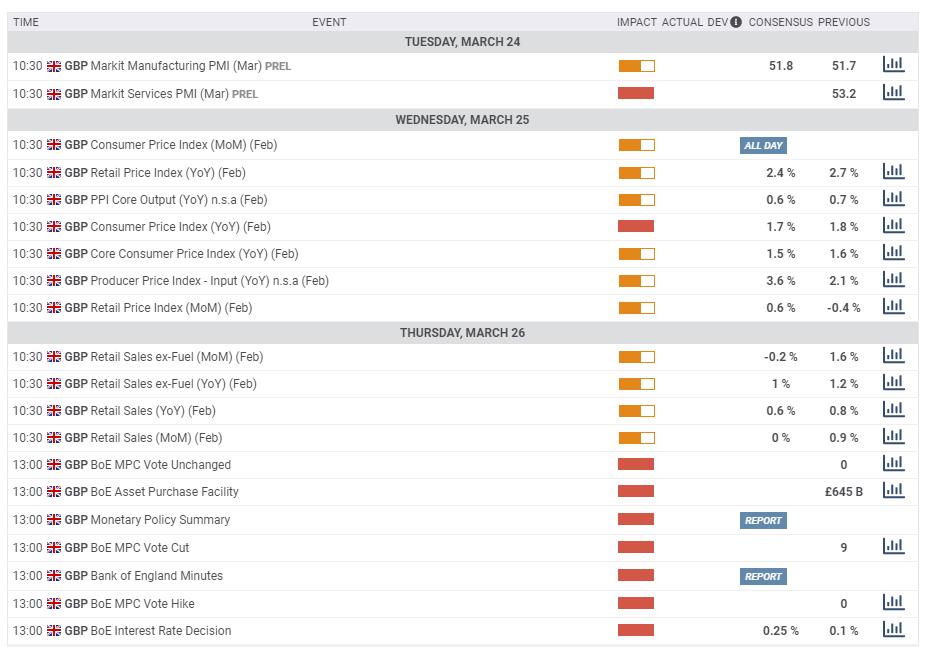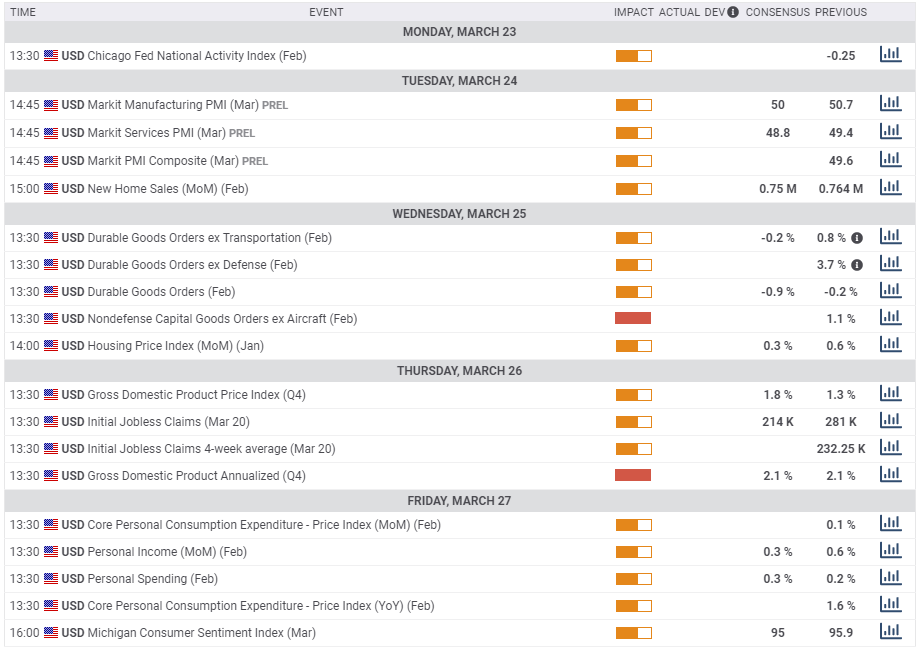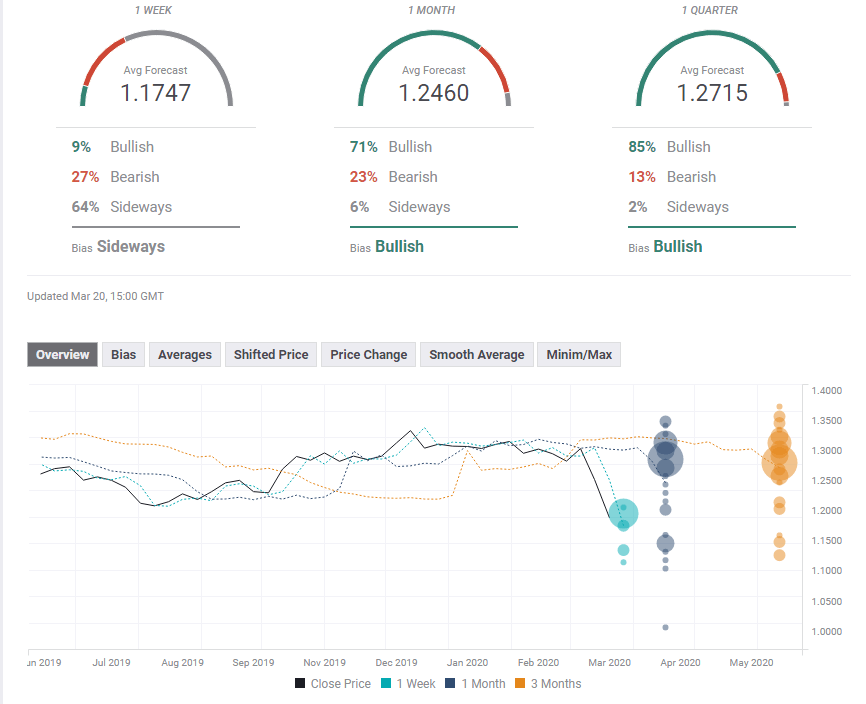- GBP/USD has crashed to the lowest levels since 1985 amid massive dollar strength.
- Coronavirus headlines and confidence-related figures are set to rock markets.
- Late March's daily chart is pointing to oversold conditions.
- The FX Poll shows consolidating in the short term with massive leaps later on.
In times of the worst extreme panic, there is only one winner – the US dollar. Funding distress sent GBP/USD to the lowest in 35 years before bouncing amid the coronavirus crisis. Where next? The focus is on coronavirus, and everything related. The only near-certainty is that high volatility is here to stay.
This week in GBP/USD: 35-year lows and extreme volatility
Pound/dollar tumbled around 1,800 pips in ten days, and that is mostly due to dollar strength. That is the summary of a week that has seen a breakneck pace of developments and extremely high volatility. The summary below provides more information about the main events that are too many to detail in full.
Fears of a massive economic hit to the global economy saw further sell-offs in markets – triggering funding stresses as investors were forced to liquidate positions. The panic sent money to the US dollar despite immense efforts to provide some calm.
The US Federal Reserve kicked off the week by cutting rates to zero in the second unscheduled move, and also announced $700 billion of new QE. Andrew Bailey, Governor of the Bank of England, cut rates to 0.10% – the lowest in the bank's 300-year history – in his fourth day on the job. He also announced £200 billion in fresh QE.
Governments on both sides of the pond are pondering additional fiscal stimulus with US efforts set to surpass $1 trillion. UK Chancellor of the Exchequer is working on new plans on a daily basis.
It is the dollar against the world – either everything falls and the dollar gains, or the other way around. New money printing has turned positive for currencies, as it funds fiscal stimulus.
See Is money printing positive for currencies? Lessons from Lagarde's largesse, Bailey's bailout
The background is the relentless spread of Covid-19, which has taken the lives of over 10,000 people, and around a quarter of a million have been infected. The US is ramping up testing efforts and is at an early stage of its lockdown measures after seemingly ignoring the issue at first. California's order to stay at home may only be the beginning.
See, Is the US already in a recession?
The UK deliberately took a different approach of "herd immunity" at first – avoiding social distancing as other countries did, and is now following peers on the continent. With new economic paralysis measures underway, the situation will likely get worse before it gets better. London is bracing for a lockdown, perhaps with soldiers on the streets.
UK events: Further lockdown measures, PMIs, and the BOE again
Coronavirus developments remain left, right, and center. The numbers of cases and deaths are expected to rise, as a long period of free movement – in comparison to various European countries – is set to take its toll. Apart from health figures, Prime Minister Boris Johnson is set to announce more restrictions.
He avoided the harshest measures and only attempted to convince people to stay at home. Despite his usual optimism, restrictions could hurt the economy. The government is likely to continue announcing measures to cushion the blow for companies and individuals.
How are businesses responding? So far, UK figures have been for the pre-crisis period, but the upcoming week's preliminary Purchasing Managers' Indexes for March. Both the services and manufacturing PMIS were above 50 in February – reflecting meager growth. They are both likely to plunge, yet the scale is unknown. A drop below 40 cannot be ruled out, and it would be harmful for the pound.
Consumer Price Index figures for February are somewhat stale but may provide insights on inflation before the crisis. Headline CPI is set to decelerate from 1.8% to 1.7%.
Last but not least, the BOE convenes for the third time this month – this time for its scheduled meeting. Can Bailey provide another bailout to the economy? The "Old Lady" is unlikely to cut rates again but may announce new lending schemes. If market conditions remain disorderly or if the government moves forward with a new stimulus, the Monetary Policy Committee could expand its QE program from the current £645 billion total volume. Additional money printing may support the currency once again.
Here is the list of UK events from the FXStreet calendar:
US events: Restrictions, layoffs, PMIs, and trillions of spending
The US has only begun kicking off its "social distancing" measures, and more are likely to come. As people take "shelter in place," companies are set to fire en masse. The first taste of that was seen in the recent weekly jobless claims release, and a much more significant rise is likely now. The weekly publication on Thursday is set to become prominent.
Health-related reports – especially in New York, the largest city and where many cases have been reported – are also set to impact sentiment.
Apart from jobless claims, Markit's forward-looking PMIs for March are set to plunge. As in the UK, the degree is unknown, and a drop under 40 would be worse than to above that level.
Wednesday's Durable Goods Orders for February and especially Thursday's final Gross Domestic Product statistics for the fourth quarter of 2019 will likely be shrugged off by investors, seeking fresh inputs. The same goes for most of Friday's figures, except the University of Michigan's final Consumer Sentiment Index for March. The preliminary report already showed a drop from above 100 to 95, and the final report may be worse. Growing health concerns and rising unemployment may send it falling.
At the time of writing, lawmakers are scrambling to finalize a gargantuan stimulus bill, worth north of $1 trillion. The market response depends on the scale and also on the details – where the devil may be. If Trump insists on a payroll tax cut – when many more people receive no payroll – markets may fall.
Last but not least, efforts to find a cure, from Gilead's Remdesivir through the use of anti-malaria drugs and up to new inventions and vaccines, may have a considerable impact as well. So far, pharma companies are working hard, but there is no clear path forward.
Here the upcoming top US events this week:
GBP/USD Technical Analysis
It is essential to note that volatility has significantly increased, while liquidity is sometimes lacking. Trading with lower leverage is warranted.
The Relative Strength Index on the daily chart is attempting to rise above 30 – exiting oversold conditions – and if that happens, it will allow for further falls. Oversold conditions reached extreme levels with the massive sell-off. Momentum remains firm to the downside, and the 50, 100, and 200-day Simple Moving Averages seem lightyears away.
The round level of 1.16 may provide some support. It is followed by 1.1440, the initial trough, followed by 1.1409, the most recent 35-year low. The next significant levels to watch are 1.12 and 1.10.
Resistance awaits at the post-crash high of 1.1878, followed by the September 2019 low of 1.1957, the round 1.20 level, and then 1.2120 that capped cable before the collapse.
GBP/USD Sentiment
Things will likely get worse before they get better, and despite increased liquidity and fiscal stimulus can only temporarily halt the tide. Substantial falls will probably follow upside corrections. In any case, volatility is set to remain elevated.
The FX Poll is showing that experts see some consolidation in the upcoming week, with cable surging in the medium and long-term to the levels seen not that long ago. It is essential to note that divergence between experts is broad amid these high volatility conditions.
Related Forecasts
- EUR/USD Forecast: Don’t get too optimistic, this is just starting
- Gold Price Forecast: Limited bounce leaves doors opened for lower lows
- Coronavirus market turmoil explained: Dollar, stocks, gold, oil, and more
Information on these pages contains forward-looking statements that involve risks and uncertainties. Markets and instruments profiled on this page are for informational purposes only and should not in any way come across as a recommendation to buy or sell in these assets. You should do your own thorough research before making any investment decisions. FXStreet does not in any way guarantee that this information is free from mistakes, errors, or material misstatements. It also does not guarantee that this information is of a timely nature. Investing in Open Markets involves a great deal of risk, including the loss of all or a portion of your investment, as well as emotional distress. All risks, losses and costs associated with investing, including total loss of principal, are your responsibility. The views and opinions expressed in this article are those of the authors and do not necessarily reflect the official policy or position of FXStreet nor its advertisers. The author will not be held responsible for information that is found at the end of links posted on this page.
If not otherwise explicitly mentioned in the body of the article, at the time of writing, the author has no position in any stock mentioned in this article and no business relationship with any company mentioned. The author has not received compensation for writing this article, other than from FXStreet.
FXStreet and the author do not provide personalized recommendations. The author makes no representations as to the accuracy, completeness, or suitability of this information. FXStreet and the author will not be liable for any errors, omissions or any losses, injuries or damages arising from this information and its display or use. Errors and omissions excepted.
The author and FXStreet are not registered investment advisors and nothing in this article is intended to be investment advice.
Recommended Content
Editors’ Picks

ECB reduces rates by 25 bps as largely expected – LIVE
On Thursday, the ECB delivered the 25 bps cut everyone expected, trimming the Deposit Facility Rate to 2.25%. EUR/USD remained within its daily sideline theme around the 1.1350-1.1360 band in the wake of the release. Now, all eyes are on Christine Lagarde’s live press conference as investors hang on her every word for clues about what comes next.

GBP/USD advances to daily highs past 1.3250
GBP/USD is picking up extra upside impulse and is revisiting the 1.3250 zone, or daily peaks, as the US Dollar is trimming part of its earlier advance. The move in Cable remains propped up by a firm tone in the risk complex.

Gold remains affered, recedes to the $3,340 area post-ECB
Gold powered to a fresh record, flirting with the $3,360 area per troy ounce, before embarking on a correction to the current $3,340 zone, always on the back of the decent rebound in the US Dollar and the recovery in US Treasury yields across the curve.

Crypto market cap fell more than 18% in Q1, wiping out $633.5 billion after Trump’s inauguration top
CoinGecko’s Q1 Crypto Industry Report highlights that the total crypto market capitalization fell by 18.6% in the first quarter, wiping out $633.5 billion after topping on January 18, just a couple of days ahead of US President Donald Trump’s inauguration.

Future-proofing portfolios: A playbook for tariff and recession risks
It does seem like we will be talking tariffs for a while. And if tariffs stay — in some shape or form — even after negotiations, we’ll likely be talking about recession too. Higher input costs, persistent inflation, and tighter monetary policy are already weighing on global growth.

The Best brokers to trade EUR/USD
SPONSORED Discover the top brokers for trading EUR/USD in 2025. Our list features brokers with competitive spreads, fast execution, and powerful platforms. Whether you're a beginner or an expert, find the right partner to navigate the dynamic Forex market.


-637203154259240797.png)
